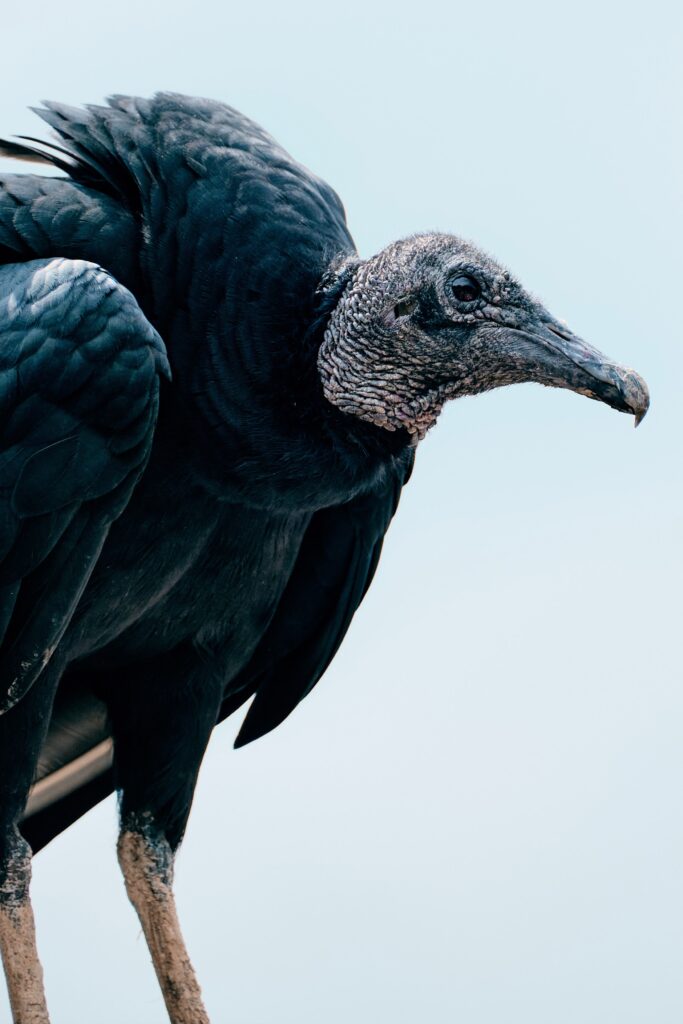



You can read it here
You can read our reviews here.
I began to be obsessed with vultures, black vultures in particular, when a committee (the word for a group of vultures) took up habitation on the roofs of the housing development where I used to live in Montgomery County, a little north and west of Philly. These were big-ass birds, with a five-feet wingspan. We lived on the top floor of one building, and we could look across to the neighboring building and see the vultures on the roof. At one point, we counted thirty-six vultures up there. They had a habit of posing with their wings out.
Imagine that the view out of your bedroom window is of close to forty of these guys in this pose.

Here’s a picture of the gathered committee on the roof next-door.

I’m focusing this discussion on black vultures, but turkey vultures also deserve a mention. According to Buffalo Bill, Center of the West, Black vultures and turkey vultures often hang out together. Turkey vultures have an excellent sense of smell, while black vultures don’t. Black vultures, however, have excellent sight. They will follow on turkey vultures, watching for when turkey vultures scent carrion. According to Mike Burke of the Bay Journal, Turkey vultures have an easier time tearing open hides, so black vultures will wait for them to do that and then join them in the feast.


It is somewhat appropriate that of all the species that climate change benefits, it is the black vulture. According to All About Birds, black vulture territory begins in Central America and continues up to the U.S., east of the Mississippi primarily, up to Southeastern Pennsylvania. According to Linda Roy of the Standard-Times, because of the warmer weather, they have been spotted as far north as New Bedford, Massachusetts, where they took over a vacant house, eyeballing passersby from the windows.
According to Audubon, it is forecast that black vultures will gain an increase of twenty-one percent in territory area because of the warmer weather. I don’t begrudge any species’s benefitting from the global catastrophe of climate change. And it seems apt that an eater of carrion would come to reign over our carbon-choked skies.

Various communities have been besieged by vultures. The University of Arkansas writes about about how vultures damage property. They prey on young livestock gruesomely, sometimes eating the eyeballs of infant animals while the animals are still alive.
According to Zariah Balentine of the Patriot News, in Derry Township, Pennsylvania, vultures have been known to go after the bears in the zoo.

According to Jason Nark of the Claims Journal, in one small Virginia town, officials set off explosions to drive a flock of vultures away. The vultures left, but they all went to the mayor’s house, where they converged on the roof. COINCIDENCE?

While some communities do what they can to get rid of their vulture problem, other communities celebrate. Makanda, Illinois holds an annual fall vulture festival. The arrival of the vultures there are said to be a sign of fall.
Athens-Clarke County in Georgia has its own festival. On the Athens-Clarke County vulture festival web page, there is a tribute to the trait of the vulture’s habit of vomiting up whatever decayed meat is in its gut if it is threatened: the vomiting distracts the threat and makes the vulture lighter, so it can more easily fly away. The vulture festival tribute is in form of a “Vulture Vomit Recipe” that calls for chocolate, graham crackers, Oreos, nuts, dried fruit, and candy corn.

According to Jim Robbins of The New York Times, The acid in a vulture’s gut is as powerful as battery acid. Their waste is so corrosive it often damages the roofs, cars, and other surfaces upon which they perch.

Because of their role as carrion eaters, vultures help prevent disease; they eat the bodies of animals that might otherwise decay in waterways, causing the spread of disease. According to The New York Times, After a massive die-off of vultures in India, the country observed an increase in reports of rabies after dogs took to consuming the carrion that the vultures weren’t around to eat.

Also, vultures are strictly monogamous, according to Mike Burke of the Bay Journal.

With that, let’s take a last look at the dudes who used to hang out at my place:


My short story “The Line” appears in the 2021 volume of ellipsis . . . literature and art
You can read it here.
My debut novel Crazybugs, a tale of bed bugs and madness and creativity, now available from Scantic Books via Amazon. You can find it here. Thank you, Scantic Books!
I review Lee C. Conley’s latest in his zombie saga, A Ritual of Flesh, for Three Crows Magazine. You can read it here.
It actually appeared last October, but for some reason my blog seems to have eaten my posting about it. Here it is.
You can read the review here:
You can read the story here: